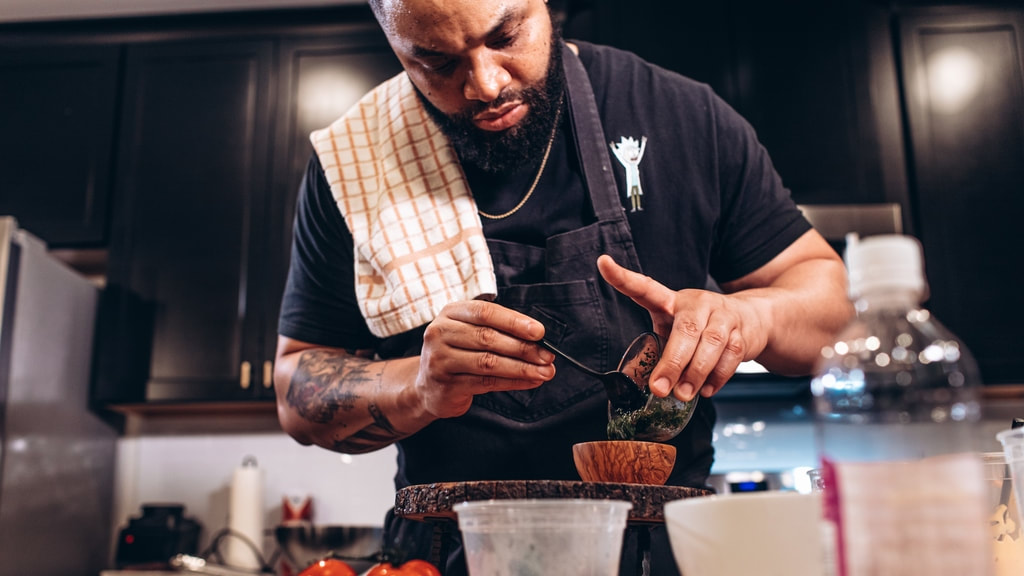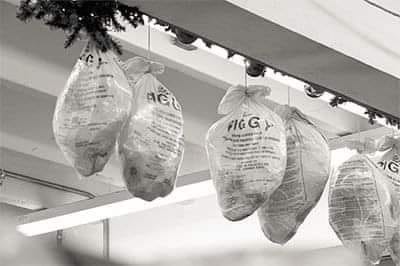|
Chris De La Rosa, Tosin Ayeronwi of Ottawa among Canadian creators chosen for the fund. Chris De La Rosa wants you to know that you can make Caribbean food no matter where you are in the world. "It's important for me to put all food and all culinary culture in a positive light," he said. "And not just that, but in a niche that breaks it down so anyone can make it no matter where in the world they're based." The Hamilton-based creator does all that and more on his channel, CaribbeanPot — which is shy of 800,000 subscribers. His videos have also garnered a combined total of 90 million views. De La Rosa's channel is the YouTube counterpart of CaribbeanPot.com, a blog he started as a way to collect recipes for his kids to make someday and document the rich cuisine he enjoyed while growing up. Now, the channel is part of #YouTubeBlack Voices class of 2022, where creators on the site receive funding and support to help grow and enhance their YouTube channels. YouTube announced the program in a 2020 blog post that outlined a multi-year, $100-million fund to amplify and lift Black voices and ideas. De La Rosa is one of five Canadian creators — including Tosin Ayeronwi of Ottawa — who have been chosen for the fund. With additional funding, he plans to tell the bigger stories behind the food he makes. "I want to tell the stories further of not just the food, but where the food comes from. I want to tell that story as well. I don't want to always be in the kitchen." Many of the meals De La Rosa knows and grew up with aren't documented, and they don't have precise measurements. "I had to create everything from scratch," he said, "and I wanted it to be very easy for them to recreate the flavours that they enjoyed growing up, even right here in Canada." Growing up in Trinidad, he said, everyone knew how to cook — whether you were a boy or girl.
"My parents have two boys and two girls, and they never assigned gender roles back then as would be normal in the Caribbean and many other places," he said. "My mom always wanted her sons, especially her boys, to be independent and do their own thing." When he was in his mid-teens, De La Rosa immigrated to Canada, where he lived with his aunt and cousins in Hamilton. Inspiring other Black creators After he was required to make some of the meals, he realized he wanted to have a taste of home again more than ever before. "When [...] it's -20 degrees outside, it's overcast, it's snowing, you want to feel like you're part of the Caribbean again." When it comes to reaching out to other Black creators on YouTube, De La Rosa finds his inspiration is helpful to those creating similar content. "If you look now, you'll find 15, 20, 30, 40 different channels with the same sort of topic that I've been doing since 2009. And if you look closely at the way they present their work, the way they edit, the way they shoot, the way they speak on camera, you will see elements of my channel on those. "I have personally reached out to a lot of these other YouTubers, these Black YouTubers, Indian YouTubers — whatever race they are, and I say, 'Can I help, how can I help? I've been doing this for so long.'" 'The space has room for everyone'Although what they do can come across as copying the content that he creates, De La Rosa reminds himself the creative space of YouTube and other online platforms is for everyone. "The space has room for everyone," he said. "It's not a competition." (Source: CBC News, Feb 8, 2022) Through his informal training to become a chef, Reuel Vincent consumed everything he could from Chef Gordon Ramsay.
On the first episode of the show Next Level Chef, Vincent, who was born in Trinidad and Tobago, had an experience he couldn't conjure up in his wildest dreams when Ramsay selected him as the first person on his team. To say it was surreal for Vincent would be an understatement. “To be honest I feel extremely excited because it is like you watch this guy on TV and he is one of my idols. I couldn’t afford to go to culinary school and Chef Ramsay had all this free content so I am a student of his. It was very surreal to know that you are the first pick of the same guy you watched, I was speechless,” he told Loop News from New York where he lives. Next Level Chef is Ramsay’s latest reality cooking series and takes place in a tri-level kitchen that ranges from world-class to barebones. The Fox series pits 15 contestants — a combination of amateur, professional and social media chefs — against each other. At the end of the first episode, five chefs were handpicked by Ramsay, renowned restaurateur Nyesha Arrington and James Beard-nominated chef Richard Blais to benefit from their mentoring for the rest of the show. Vincent, who was in the group operating in the barebones basement kitchen, impressed Ramsay with his creative and flavourful meal made from Spam. “The only thing that came to my mind was that I could treat it like corned beef but corned beef breaks up so I said let’s do this up the best I can,’ he said of the competition. Browsing through Vincent’s Instagram pages, it is clear that he isn’t afraid to tackle any dish. From Asian cuisine to baked products, Vincent challenges himself to master any ingredient that is placed before him in his quest to stand shoulder to shoulder with the best. His mantra, “I'm not passionate I'm hungry” best describes his attitude which is fuelled by his lack of formal training. Unlike many chefs, Vincent didn’t go to school to learn culinary arts; his training came from watching people like Chef Ramsay and practical experience, working with his aunt in her catering business after he dropped out of college. “I always loved cooking but I guess within society they had this thing about going to college and that is how you make it. I went to Andrews University to do physical therapy but it was boring and I told my mum I wanted to go back to New York but she said no. I switched to nursing but I said nah, I washed my hands of that and went back to New York. I had to work because I had a lot of student debt and my aunt owned a catering company in Manhattan. She ran me through the wringer, she made me work for every single penny but I learned a lot,” he recalled. Vincent graduated from his aunt’s business to the One World Trade Centre where he works today as a banquet chef serving celebrities and high-end clientele from all over the world. Applying to be on Next Level Chef was his way of sealing his prowess in the kitchen. “People look at not being formally trained as a crutch but it is fuel, you overlearn to compensate. If you go to school and have a degree hanging on the wall, you think you are done, I am never done,” Vincent declared, noting that he has sacrificed everything, including relationships, for his career. Vincent’s interest in food began in T&T. Growing up in Sangre Grande with his maternal great-grandmother and grandmother after his parents split and his mother migrated to the US, he learned a lot that stayed with him to this day. “My great-grand is Carib and she taught me a lot of ways of cooking. My grandmother would wake me up to go on the market run and she kept me on her hips the whole time in the kitchen so I learned things like how to break down a chicken. You know older Caribbean women would teach you everything so no one could cut style on you,” he said. He also learned a lot from his dad who lived in Maracas, St Joseph, and worked as a taxi driver. Vincent bonded a lot with his father when he attended Caribbean Union College. Describing his late dad as a "bush cook", he recalled watching him bubble large pots of soup and wild meat. “I learned how to season food from him. His favourite thing was curry duck and dumpling. He took me to my first river lime at Caura around the age of nine and as a kid, whenever he made the dumpling in the big pot, I would take the pot afterward and put it on my head and end up with pieces of dumpling in my hair,” he said with a laugh. Vincent migrated to the United States two weeks before 9/11 to live with his mother. He said though his father never went to the US, he asked a lot about the food over there. As Vincent started cooking for himself, his dad walked him through the process. He said from his life in Trinidad, he learned how to deal with raw ingredients and the basics of flavour. “If you are doing pelau or curry, they seem simple but they are layered. I used to watch my dad make curry dishes and he would add water to the curry before he put it in the pot. Now I understand the science behind that. We add water to the curry for it to bloom, the steam makes the curry bloom and the aromatic flavours open up,’ he explained. Vincent, who last visited T&T around the mid-2000s, dreams of opening a restaurant in the land of his birth one day. Until then he will continue building his name and his appearance on Next Level Chef might be just the show to put him on the map. “Strap in,’ he said of the show. “This is gonna be a good one.” (Source: The Loop, Jan 5, 2022) From Tar Hams to Salt Butter
...PoS grocery takes shoppers back to old-time days Credit to Author : Charles Kong Soo Sing Chong Supermarket on Charlotte Street, Port-of-Spain, is a modern supermarket, but shoppers can feel as if they stepped through a time warp to the old-time days of Chinese shopkeepers and parlours on the village corner.In one section of the supermarket you can find loose salt butter, table margarine, lard and peanut butter packed neatly in white wrapping paper just like in "Mr Chin's" shop from a bygone era. The culinary treasure that attracts foodies and tantalises the taste buds of the golden generation alike, however, is the tar ham hanging from the ceiling. This is the same type of ham granny and grandpa used to boil in a biscuit tin over a wood fire or pitch-oil stove in the backyard and sometimes baked after in a coalpot tin oven or mud oven. Anthony Low, the supermarket's owner, said since his father, Johnson Achong Low opened Sing Chong's in the 1940s they were importing premium tar hams or soak and boil hams as they were also called.He said, "Since I was 14 years old and working with my father, in those days we were bringing in Darling Downs ham from Australia and Swift's ham from the US encased in tar."Tar and Darling Downs ham got expensive, and when Government banned ham importations in the '70s it became too prohibitive. "When the market opened up in the '80s I began bringing in this brand, 'Piggy' ham every year."Low's son, Christopher, said he knew of the ham hanging from the supermarket's ceiling since he was small.He said when the distributor was no longer importing salt hams, the supermarket decided to source it for itself.Christopher said there were not many other supermarkets selling the traditional hams. Low said not everyone had a fridge in the early days, that the ham didn't need refrigeration, and it could last for three years with just some loss in weight.He said even when it was cooked, the ham could be left outside covered and it wouldn't spoil.Low said people started using big pots to cook their hams in when they became available, and the unique smell given off by the ham cooking in the yard wafting in the open air could be detected by neighbours a great distance away. He said he kept at least 12 hams for himself and boils one every month to share with his family, friends and employees, and it goes very fast.Low said a customer bought a soak and boil ham and returned it on Christmas eve 2012 "burnt like charcoal," asking him if he knew how to cook it.The man said his mother had died and she cooked the ham for his family every year when she was alive.He had never learned how to prepare the ham, and he had put it in the oven to bake. Low gave the man the cooking instructions: soak the ham for three to four days, add lime or sugar, discard the water every day, boil for at least two hours until done, bake after if so desired, adding cloves and pine for a different flavour.He gave the man a replacement ham. The man returned to him after Boxing Day to say thanks as it came out "perfectly" like his mother's.Low's plan is to ask the manufacturers to place cooking instructions with the hams in the next shipment. __________________________________________ According to Historian Angelo Bissessarsingh tar hams were made locally in the South-West peninsula from the '30s up to the early '50s Source: Virtual Museum of TT, Dec 24, 2021 While parang music is being played in the background, Trinidadian kitchens will be busy making pastelles during the holiday season.
Pastelles are a Caribbean dish similar to tamales and are traditionally made at this time of the year, says Arielle Neils, executive chef with Kitchener, Ont.'s the Compass Group, including in her home. "It's said that they are a very old dish coming from Spanish influence," Neils says of the Trinidadian version she loves to prepare. "Making them brings me back to being in the kitchen with my mother and grandmother at Christmas time." Beef or chicken is sautéed with capers, olives, raisins and other aromatics, which are then stuffed into a pocket of corn flour dough and wrapped and steamed in a banana leaf. "It's important to note that we use corn flour, not cornmeal," Neils said. Grandmother taught her to cookShe has been making pastelles since she was seven years old in Chaguanas in central Trinidad, helping her grandmother, who was a chef and caterer. "My grandmother was the first person who taught me to cook. She's still with us and represents the mix of cultures that is Trinidad," Neils says. "When I was 13 years old, my grandmother took a catering job for a huge number of pastelles. It took us two days to make them all. We worked very hard and they surprised me by getting me a cellphone when we were done." Learning to cook at a grandmother's elbow is a common memory shared by many chefs. From a dough-making perspective, Neils learned the importance of touch and feel — how a successful pastelle dough must be pliant and malleable. "My grandmother taught me to squeeze the dough and if a crack forms, it needs more liquid because it is too dry." Typically eaten close to Christmas Day, pastelles seem to inspire people to assemble them much earlier, according to Neils. "I was looking on Facebook in November and people have already started making and eating pastelles." 'Heart, passion and love' go into pastellesThe process isn't necessarily difficult, but there are several steps so Neils advises getting all your ingredients ready and waiting before starting to cook. While some cooks boil pastelles, she prefers to steam them for a better texture. She said you can omit the butter and meat in the ingredients and use lentils for vegan pastelles. Neils recommends visiting Latin and West Indian grocery stores for supplies such as green seasoning and banana leaves. "As for the Scotch bonnets, if you don't like too much heat, remove the seeds and membrane, or leave them out all together," she said. The tactile act of working the dough and folding it into banana leaves also stirs memories of childhood for Neils. "Making pastelles, I start to feel warm inside. There is heart, passion and love that goes into making them," she said, adding it's important for her to pass along the tradition to her son. "Pastelles … bring me fond memories of working in the kitchen with my mother and grandmother; they feed the soul and create happiness and fulfilment. "They are the ultimate Christmas food in my culture." Beef pastelles by chef Arielle NeilsIngredients For the dough:
Marinate ground beef with green seasoning and refrigerate, preferably overnight. Add marinated ground beef to a hot pan and cook for six minutes or until meat is browned. Add onions, celery and garlic, sauté for three minutes, then add pimento peppers, olives, capers, Worcestershire, annatto, raisins, salt and pepper. Sauté until peppers and raisins have softened and any liquid has evaporated (about four to five minutes). Turn off heat and add green onions and Italian parsley, then set aside to cool. In a medium bowl add warm water and butter. In another medium bowl add corn flour, beef bouillon and sugar (pinch of salt and pepper is optional). Once butter is melted in water, begin adding the water mix little by little to the corn flour until dough comes together and is very soft. Divide the dough into six roughly equal parts. Wash and dry your hands and then rub your palms together with oil. Spoon the dough into your oiled hands and shape into a ball, one by one; they don't need to be perfect spheres. Cover the dough balls with a wet towel and set aside. Add water to a pot or steamer, place on medium-high heat and allow water to come to a boil. A colander over a pot of boiling water also works well. Cut seven pieces of banana leaf and use a brush to oil the flat side of the banana leaf. Method for banana-leaf wrappers: Ensure banana leaf is on a flat surface and place dough in the middle of the greased side of the banana leaf; cover with another piece of banana leaf, greased side down to touch the dough then press dough to open up (it doesn't have to be a perfect circle). If using a tortilla press, follow the same method and continue with all the dough balls. Feel free to stack them in the press. Add cooked meat to the middle of the opened up pastelle dough. Gently fold the leaves in two opposite sides, one at a time over the filling, then fold in the remaining two ends to enclose the pastelle. If boiling, cut pieces of butcher's twine and tie around the pastelle in the banana leaves so they don't open when boiling. If steaming, skip this step as you can steam seam side down. Steam or boil for 15 to 20 minutes then remove from heat and allow to cool for five minutes in a colander. Unfold, eat and enjoy! These can be refrigerated for up to four days or frozen for up to three months then steamed or boiled as you go. If steaming before freezing, they can be reheated (two at a time) in a microwave with a small bowl of water beside them. Source: CBC News, Dec 11, 2021 |
T&T news blogThe intent of this blog is to bring some news from home and other fun items. If you enjoy what you read, please leave us a comment.. Archives
July 2025
Categories
All
|







 RSS Feed
RSS Feed